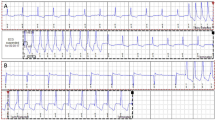Summary
This study was carried out to evaluate the influence of long-term treatment with doxorubicin (DXR) (4mg/kg IV for 5 weeks) on heart and liver lysosomes of mice.
We evaluated the variations in both total and “sedimentable” enzyme activity of cathepsin D, which is the major endopeptidase of myocites and probably involved in physiologic and pathologic degradation of actomyosin and mitochondria, and that of acid phosphatase, which is more prominent in interstitial cells.
Our results show that marked changes occur in both total and sedimentable enzyme activity of cathepsin D in the heart of treated animals and to a lesser extent in the liver.
In contrast, no modification of either total or sedimentable acid phosphatase was seen in either organ.
The effects we observed are much more marked for cardiac cathepsin D; this is in good agreement with the cardiac specificity of DXR-induced cardiotoxicity with long-term administration and suggests that lysosomes could play a role in the pathogenesis of this phenomenon.
Similar content being viewed by others
References
Allan RM, Welman E (1980) Proteolysis of isolated mitochondria by myocardial lysosomal enzymes. Biochem J 190:139–144
Arena E, D'Alessandro N, Dusonchet L, Rausa L, Sanguedolce R (1975) Adriamycin and Daunomycin-induced cardiotoxicity: Effects on DNA, RNA and proteins synthesis in mouse heart after strophanthin pretreatment. IRCS Med Sci 3:190
Bachur N, Gordon SL, Gee MV (1978) A general mechanism for microsomal activation of quinone anticancer agents to free radicals. Cancer Res 38:1745–1750
Barrett AJ (1972) Lysosomal enzymes. In: Dingle JT (ed) A laboratory handbook, North Holland, Amsterdam, pp 46–135
Barrett AJ, Dingle JT (1972) The inhibition of tissue acid proteinase by pepstatin. Biochem J 127:439–441
Bristow MR, Scott Sageman W, Scott HR Billingham ME, Bowden RE, Kernoff RS, Snidow GH, Daniels JR (1980) Acute and chronic cardiovascular pharmacology of drug-induced histamine release. J Cardiovasc Pharmacol 2:487–515
De Duve C, De Barsy T, Poole B, Trouet A, Tulkens P, Van Hoff F (1974) Lysosomotropic agents. Biochem Pharmacol 23:2495–2531
Doroshow JH (1983) Effect of anthracycline antibiotics on oxygen radical formation in rat heart. Cancer Res 43:460–472
Duarte-Karim M, Ruysschaert JM, Hildebrand J (1976) Affinity of Adriamycin to phospholipids. A possible explanation for cardiac mitochondrial lesion. Biochem Biophys Res Commun 71:658–663
Dusonchet L, Crosta L, Bellini O, Flandina C, Palmeri S, Valso F, Rausa L (1984) The influence of multiple treatment with doxorubicin or 4'-deoxy-doxorubicin on the DNA synthesis and morphology of mouse heart. Int J Tiss React 6:81–89
Hines JL, Ogunro EA, Ferguson AG, Lesch M (1982) Cathepsin D catalyzed degradation of cardiac mitochondria. A study of enzyme inactivation and ultrastructure. J Mol Cell Cardiol 14:91–97
Jaenke RS (1974) An anthracycline antibiotic-induced cardiomyopathy in rabbits. Lab Invest 30:292–304
Kao R, Rannels DE, Morgan H (1975) Preparation of homogenates of heart muscle for the assay of lysosomal enzyme activities. In: Dingle JT, Dean RT (eds) Lysosomes in biology and pathology, vol 4 North Holland, Amsterdam Oxford, pp 184–187
Lowry OH, Rosebrough NJ, Farr AL, Randall RJ (1951) Protein measurement with the Folin phenol reagent. J Biol Chem 193:265–275
Mettler FP, Young DM, Ward JM (1977) Adriamycin-induced cardiotoxicity (cardiomyopathy and congestive heart failure) in rats. Cancer Res 37:2705–2713
Mikkelsen RB, Lin PS, Wallach DHF (1977) Interaction of Adriamycin with human red blood cells; a biochemical and morphological study. J Mol Med 2:33–40
Morgan HF, Rannels DE, Kao RL (1974) Factors controlling protein turnover in heart muscle. Circ Res 35/35 [Suppl III]: 22–29
Murphree SA, Cunningham LS, Hwang KM, Sartorelli AC (1976) Effect of Adriamycin on surface properties of sarcoma 180 ascites cells. Biochem Pharmacol 25:1227–1231
Noel G, Peterson C, Trouet A, Tulkens P (1978) Uptake and subcellular localization of Daunomycin and Adriamycin in cultured fibroblasts. Eur J Cancer 16:363–368
Ogunro EA, Lanman RB, Spencer JR, Ferguson AG, Lesch M (1979) Degradation of canine cardiac myosin and actin by cathepsin D isolated from homologous tissue. Cardiovasc Res 13:621–629
Schwartz WN, Bird JWC (1977) Degradation of myofibrillar proteins by cathepsin D and B. Biochem J 167:811–820
Snedecor GW, Cochran WG (1982) Statistical methods 7th edn. The Iowa State University Press, Ames, Iowa, USA pp 54–56
Solcia E, Ballerini L, Bellini O, Magnini V, Bertazzoli C, Tosana G, Sala L, Balcani F, Rallo F (1981) Cardiomyopathy of doxorubicin in experimental animals. Factors affecting the severity, distribution and evolution of myocardial lesions. Tumori 67:461–472
Thayer WS (1977) Adriamycin stimulated superoxide formation in submitochondrial particles. Chem Biol Interact 19:265–278
Wildenthal K (1975) Lysosomes and lysosomal enzymes. In: Dingle JT, Dean RT (eds) Lysosomes in biology and pathology, vol 6 North Holland, Amsterdam Oxford pp 167–190
Wildenthal K (1978) Lysosomal alteractions in ischemic myocardium: Results or cause of myocellular damage? J Mol Cell Cardiol 10:595–603
Young RC, Rosenoff S, Olsen HM (1974) Alteration in DNA synthesis in cardiac tissue and light microscopic and ultrastructural cardiac damage induced by Adriamycin in vivo: relationships to fatal toxicity. In: Staquet M, Tagnon H, Kenis Y, Bonadonna G, Carter SK, Sokal G, Trouet A, Ghione M, Praga C, Lenaz L, Karim OS (eds) Adriamycin review. European Press Medikon, Ghent, pp 149–159
Author information
Authors and Affiliations
Additional information
Supported by CNR (National Research Council) contract No. 83.00923.96
Rights and permissions
About this article
Cite this article
Gebbia, N., Leto, G., Gagliano, M. et al. Lysosomal alterations in heart and liver of mice treated with doxorubicin. Cancer Chemother. Pharmacol. 15, 26–30 (1985). https://doi.org/10.1007/BF00257289
Received:
Accepted:
Issue Date:
DOI: https://doi.org/10.1007/BF00257289




